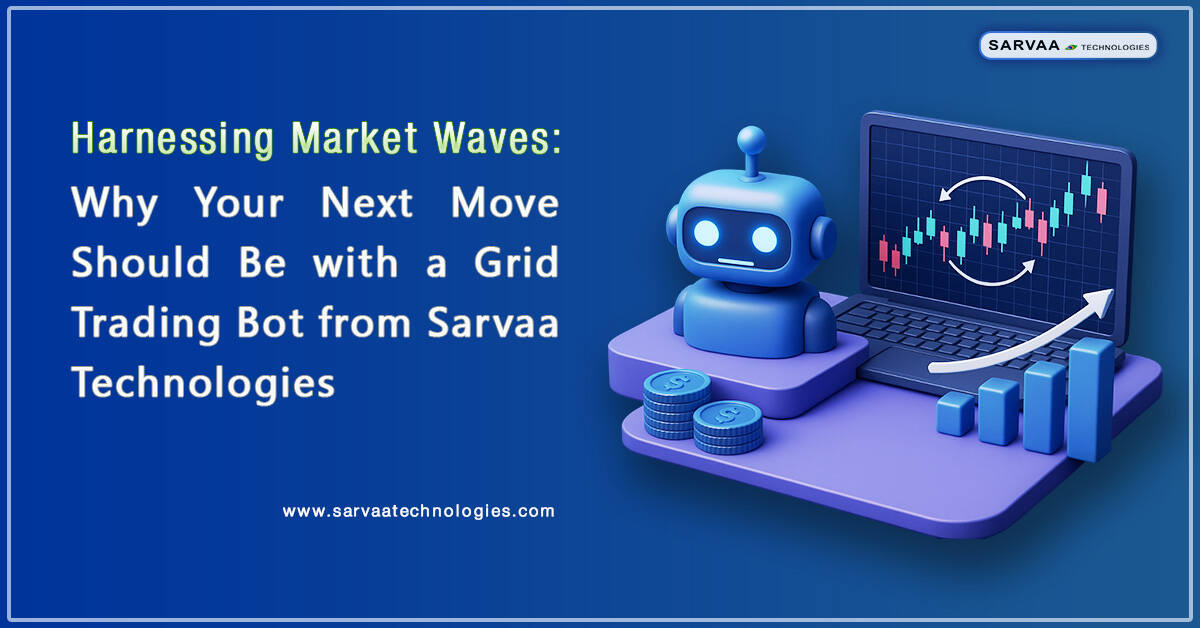The crypto ecosystem has become a space where speed, liquidity, and precision decide how successful a trading environment can truly be. As digital assets continue to gain wider adoption, the expectations placed on trading infrastructure have grown just as rapidly.
Traders want tighter spreads, token projects want healthier market activity, and exchanges aim to sustain vibrant order books even during quiet hours. Meeting all these expectations manually is becoming increasingly unrealistic, which is why market making automation has shifted from a luxury to a necessity.
At Sarvaa Technologies, we’ve watched this change unfold closely while working with businesses that need stronger liquidity support. Market making bots are evolved into advanced systems capable of analyzing order books, reacting to market movements within milliseconds, and maintaining balanced positions without constant human involvement. This shift is shaping the new backbone of digital asset trading.
Brands, projects, and funds are now looking for solutions that can keep up with an environment where volatility can appear within minutes and opportunities disappear even faster. A well-built market making bot ensures that markets stay active, orders remain consistent, and trading pairs attract more participation over time. It creates a smoother experience for traders and a more stable foundation for token exchanges.
Followingly, this blog explores how modern market making bots work, what separates an average system from a high-performing one, and how a development partner like Sarvaa Tech approaches building these intelligent liquidity engines.
The goal is to help businesses understand the value behind such automation and how it can shape stronger growth as the digital asset space continues moving forward.
Understanding Market Making in Today’s Crypto Landscape
Market making might sound complex on the surface, but at its core, it’s simply about ensuring that traders always find someone to buy from or sell to. In traditional finance, large institutions usually handle this role. In the crypto world, however, the responsibility often falls on automated systems because markets operate nonstop and demand constant attention.
Without active market makers, trading pairs can feel empty, spreads widen, and users lose confidence in the asset’s stability. Today’s crypto market is a mix of fast-moving projects, global exchanges, and a wide variety of tokens competing for visibility.
Each of them relies heavily on liquidity and the ease with which trades can happen without causing large price swings. This is where market making becomes a critical foundation. It’s about creating a trading experience that feels smooth, responsive, and trustworthy for every participant while placing orders.
Exchanges often encourage token projects to maintain liquidity because it keeps the ecosystem healthy. Projects, in turn, want to make sure their token doesn’t appear stagnant or difficult to trade. At the same time, traders expect stable pricing and reliable execution whenever they choose to enter or exit a position. All these expectations converge into one simple requirement: consistent, intelligent activity in the order book.
The crypto space has also matured enough that manual interventions alone can not keep pace. Markets react to global news, algorithmic trading activity, and rapid shifts in supply and demand.
This has pushed businesses to explore automated systems that can adapt to these movements faster and more efficiently than a human ever could. Understanding this landscape helps highlight why market making bots have become a central component of modern crypto operations.
Why Businesses Are Turning Toward Market Making Bots Instead of Manual Trading
Most teams in the crypto world eventually reach a point where they realize that trying to manage liquidity by hand is simply not practical anymore. At first, placing orders manually or adjusting positions now and then seems manageable.
But as markets grow busier and trading becomes more competitive, the workload turns into something no person can realistically keep up with. Prices jump without warning, spreads shift constantly, and opportunities can disappear before someone even finishes reviewing the chart. That’s usually the moment businesses start looking toward automated systems.
A well-built market making bot takes over the parts of the job that demand fast reactions and constant attention. Instead of someone sitting in front of multiple screens all day, the bot quietly handles the routine tasks: placing orders, pulling them when conditions change, managing inventory so it doesn’t drift too far in one direction, and keeping the pair active even during slow hours. Businesses appreciate this consistency because it removes the stress of trying to juggle everything manually.
Another shift happens when teams realize how emotions influence human decision-making. It’s natural when the market suddenly moves, traders feel pressure, and that pressure often leads to hesitation or rushed choices. Automated systems don’t experience that. They follow rules, stick to the plan, and avoid the kind of impulsive actions that usually create losses.
There’s also the practical side: running liquidity operations manually is expensive. It means hiring more people, covering more time zones, and dealing with inevitable mistakes. A market making bot replaces all of that with a system that works quietly in the background, doing the same job far more efficiently.
In the end, businesses don’t switch to bots because they want to “automate everything.” They do it because the market moves too quickly to rely on human reaction alone and because a stable, always-present strategy simply works better for long-term growth.
Core Foundations of a High-Performance Market Making Bot
Behind every good market making bot, there’s a set of essential building blocks that allow it to behave almost like a skilled trader who never sleeps. While different businesses may prioritize different goals, the underlying structure of a reliable market making system is surprisingly consistent.
- It starts with the bot’s ability to read the order book properly. Without an accurate understanding of how buyers and sellers are positioned, no automated strategy can make smart decisions. A strong system constantly monitors changes in depth, spreads, and volume so it can adjust its orders with confidence.
- Another foundational element is the way the bot manages spreads. The goal is to position orders in a way that encourages smooth trading activity without exposing the business to unnecessary risk. This requires a balance tight enough to attract traders, yet flexible enough to adapt when the market suddenly becomes more active or unpredictable.
- Inventory control is just as important. A bot needs to avoid holding too much of one asset or too little of another. If it becomes lopsided, it can’t support both sides of the market effectively. A well-structured system keeps an eye on how much of each asset it holds and adjusts its strategy before imbalances grow into bigger issues.
- Connectivity and execution speed also shape how effective the bot can be. Crypto markets don’t wait, and a delay of even a few seconds can make a big difference. Clean API integration, fast order execution, and the ability to react quickly to new data help the system remain competitive throughout the day.
Together, these foundations create a bot that not only supports consistent liquidity but also responds intelligently to whatever the market throws at it.
Our Approach at Sarvaa Technologies: How We Build Market Making Bots That Adapt and Evolve
At Sarvaa, our work with market making systems has taught us one simple lesson: every project is different, and a one-size-fits-all bot rarely performs well in the real world. That’s why our development process starts long before any code is written. We begin with conversations understanding what the business wants to achieve, the kind of trading environment it deals with, and the specific challenges it faces. This helps us shape a system that fits the project rather than forcing the project to fit the system.
Once the goals are clear, we build the bot’s structure in a modular way so that each part can evolve as the market changes. Instead of locking everything into a rigid framework, we allow the bot to grow. This makes it easier to introduce new strategies, fine-tune behaviors, or expand to additional trading pairs without rebuilding everything from scratch. It keeps the system flexible in an environment that constantly shifts.
We also focus heavily on testing. Before a bot ever touches a live market, it goes through simulated environments where we stress-test its reactions to sudden swings, thin order books, and periods of heavy volatility. These scenarios help us identify weak points and refine the logic until the bot behaves reliably across different conditions.
Our team then monitors the bot closely during deployment, making adjustments as new market patterns appear. We focus on delivering a functional system that continues learning and adapting over time. That long-term mindset is what allows Sarvaa Tech to build solutions that work all the time and stay relevant as the market grows more complex.
Key Features of a Modern Crypto Market Making Bot
When people first hear about market making bots, they often imagine something basic, maybe a script that places a few orders now and then. In reality, the tools that actually perform well today are far more sophisticated. They behave almost like someone who has been watching the market for years and knows how to read the room instantly.
One of the first things that stands out in a good bot is how it handles spreads. It is not simply to keep them fixed or predictable. Instead, it adjusts naturally depending on what’s happening in the market. If things are calm, the bot tightens its positioning to encourage activity. When the market becomes noisy or uncertain, it gives itself a little more room. This kind of flexibility is something a human might take minutes to decide, but a modern system does it without hesitation.
Another part that makes a noticeable difference is how aware the bot is of volatility. Good systems don’t stop with following the price; they watch how quickly it moves, how other traders are behaving, and how the order book changes from second to second. If the market suddenly becomes unstable, the bot adapts its behavior instead of blindly placing orders where they shouldn’t be.
Handling multiple exchanges has also become almost a necessity. Many projects don’t want their token to look active on one platform and lifeless on another. A capable bot can quietly manage several exchanges at once, keeping the trading experience consistent everywhere.
There’s also a subtle but powerful feature many people overlook: the bot’s ability to anticipate pressure in the market. By studying how orders stack up, it gets a sense of where sudden buy or sell interest might appear. This helps it stay positioned in a way that feels steady rather than chaotic.
Put together, these features give the bot a personality steady, observant, and quick to respond. And that kind of behavior is what keeps a market healthy without drawing attention to the machinery running behind it.
Integrating Automated Strategies: From Basic Algorithms to Advanced Liquidity Engines
The strategies that power a market making bot can range from simple to surprisingly complex, and the difference between them often decides how well a token performs in active markets. Many people start with the idea that a bot only needs a basic algorithm to place orders on both sides of the book. While that may be enough for the earliest stages of a project, the reality is that markets rarely stay predictable for long, and relying on a single static approach usually leads to uneven results.
A more capable system blends several strategies together, allowing the bot to switch its behavior depending on what’s happening around it. For example, margin-aware logic helps the bot stay cautious when it senses that the market is leaning too heavily in one direction. Instead of letting positions grow out of control, it adjusts its placement so the inventory stays balanced. This gives the bot room to breathe even when the market starts pushing harder than expected.
Another useful layer is multi-pair management. Businesses dealing with multiple trading pairs quickly realize that each pair behaves differently. A system that handles them individually, respecting their unique flows, tends to maintain far better liquidity.
Advanced bots also include decision-making frameworks that borrow ideas from professional trading desks. These can involve micro-prediction models that observe silent changes in volume or order-book pressure and respond before the shift becomes obvious to the average trader. Instead of simply reacting, the bot prepares itself.
Bringing all these ideas together turns the bot into more than a simple tool. It becomes a structured liquidity engine, one that understands context, works across different environments, and contributes to a smoother market without needing constant babysitting.
Why Choosing a Reliable Market Making Bot Development Company Matters
In the crypto space, the quality of a market making bot can genuinely influence how traders perceive a token. A smooth and active market feels inviting, while a poorly supported one becomes quiet, unpredictable, and sometimes even mistrusted. Because of that, choosing who builds the bot is almost as important as the bot itself. Many teams learn this the hard way after trying low-cost or generic solutions that look fine at first but fall apart when real trading pressure appears.
One common problem with off-the-shelf bots is that they’re built to serve every project in the same way, regardless of how different those projects are. Markets behave differently from pair to pair, and a system that treats them all equally usually struggles to maintain consistency. That’s where experienced developers make a noticeable difference. A good development partner studies the token’s behavior, its trading environment, and the kind of liquidity it needs before shaping any strategy.
There’s also the matter of reliability. Bots that crash during high activity, misread order books, or fail to react quickly can do more harm than good. A trustworthy development company focuses on stability first, clean integrations, efficient code, precise order handling, and the kind of monitoring tools that catch issues before they become serious.
Security is another area that shouldn’t be overlooked. A market making bot works directly with sensitive API keys and handles valuable assets. You want that system built by people who understand both trading logic and security practices.
Teams often come to Sarvaa Technologies after realizing that their earlier solutions weren’t built for long-term use. What they really needed was a partner that treats market making as a continuous responsibility rather than a quick, one-time setup.
Real-World Use Cases: How Tokens, Exchanges, and Funds Benefit from Custom Market Making Bots
When people talk about market making bots, it often sounds technical until you see how they actually help different players in the crypto space. Token projects, for example, notice the difference almost immediately. A new token that has just gone live usually struggles with thin order books, which can make even small trades look dramatic on the chart. A custom market making bot smooths out those early days by keeping activity steady and preventing price swings that scare off curious buyers. It gives the project a healthier start and sets the tone for a more stable trading environment.
Exchanges benefit just as much. A trading platform lives or dies by how active its markets feel. If users open a trading pair and see an empty book, they rarely come back. With the right bot supporting key pairs, an exchange can maintain depth, create a more welcoming flow, and encourage traders to stick around. This is especially useful for mid-sized platforms expanding their listings and trying to attract new communities.
Funds and professional trading teams also rely heavily on these systems. Their goal is to maintain disciplined entry and exit points in the market without having to monitor everything manually. A tailored bot helps them manage inventory, reduce slippage, and stay consistent across multiple pairs without the fatigue that comes with manual oversight. For them, the bot becomes a dependable part of their toolkit.
In each of these situations, the value doesn’t come from automation alone. It comes from a system that understands the role it’s meant to play and works quietly in the background, making the trading experience smoother for everyone involved.
The Future of Market Making Automation: What’s Ahead for the Next Wave of Innovation
If there’s one thing everyone in the crypto world agrees on, it’s that the way markets behave today won’t be the same a few years from now. Trading patterns evolve, new asset types emerge, and exchanges constantly introduce fresh features. Because of that, the next wave of market making automation is expected to lean much more toward intelligence.
One of the biggest shifts already taking shape is the move toward systems that understand context. Instead of only following predefined rules, future bots are expected to learn from patterns how traders behave during certain hours, how liquidity spreads across platforms, and how sudden bursts of activity often follow specific signals. This kind of awareness allows a bot to position itself more naturally, almost as if it’s reading the market’s mood.
Another area that’s gaining attention is cross-platform execution. Right now, many bots handle each exchange separately, but the landscape is moving toward more connected strategies. Businesses want smoother coordination between platforms so the token feels balanced wherever it trades. This requires smarter routing, quicker decision-making, and systems that can manage several environments without being overwhelmed.
There’s also growing interest in cleaner, regulation-friendly designs. As more regions introduce clearer rules around digital assets, companies are looking for bots that behave transparently and follow structured guidelines. The future will likely favor systems that prioritize responsible behavior while still offering strong performance.
All these changes point toward one outcome: market making bots are slowly evolving from tools into strategic partners. They’ll help shape healthier markets, placing orders, support long-term liquidity, and give businesses more confidence as the industry matures.
As A Conclusion
Market making has quietly become one of the most important foundations of the crypto space. Whether someone is launching a new token, running an exchange, or managing a trading operation, the quality of liquidity often shapes how people experience the market.
A reliable, well-built market making bot creates an environment where users feel confident, where prices behave more naturally on buying and selling orders, and where projects can grow without being held back by unstable trading conditions.
What we’ve seen at Sarvaa Technologies is that businesses want systems that genuinely understand the rhythm of the market and adjust themselves without constant supervision. They want a partner who listens, builds with intention, and continues refining the system as the landscape shifts. That mindset is what turns a market making bot from a simple tool into something that actively supports long-term stability.
As the crypto ecosystem keeps evolving, the demand for thoughtful, adaptable automation will only become stronger. The projects that succeed are often the ones that treat liquidity as a responsibility. And the bots that succeed are the ones built with care, tested with patience, and improved continuously from the start to throughout their lifecycle.
In the end, it’s to replace human insight. It’s to create a reliable framework that allows businesses to focus on strategy while the bot handles the constant, repetitive, high-speed work in the background. With the right development partner and a system designed to grow alongside the market, maintaining healthy liquidity becomes far more achievable and much less stressful for everyone involved.
For consulting, please feel free to connect with us. We’re always ready to hear from you!





